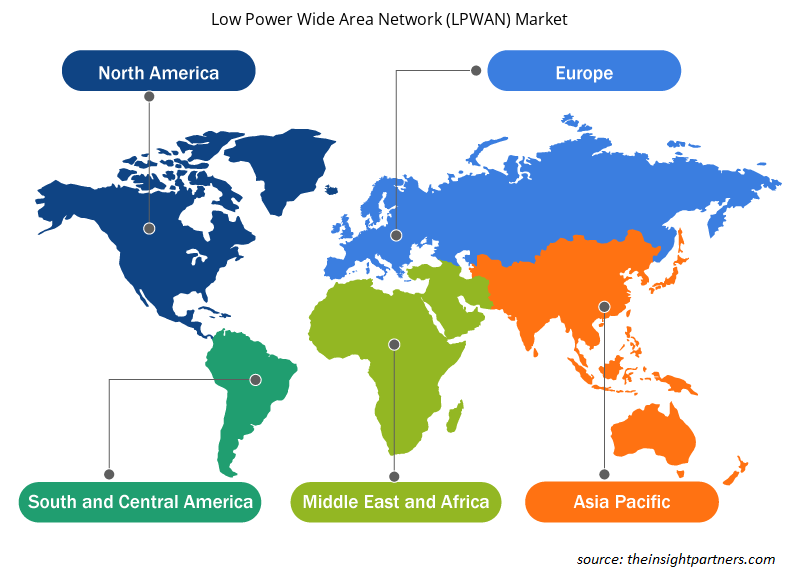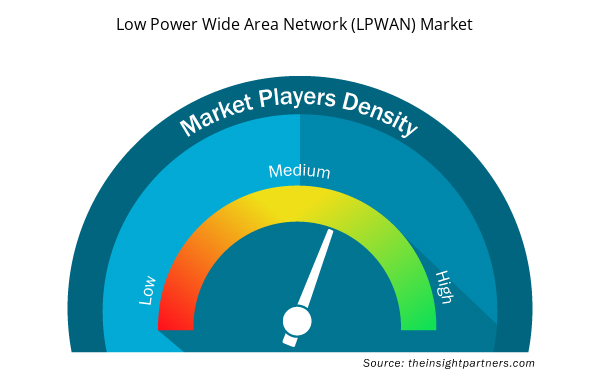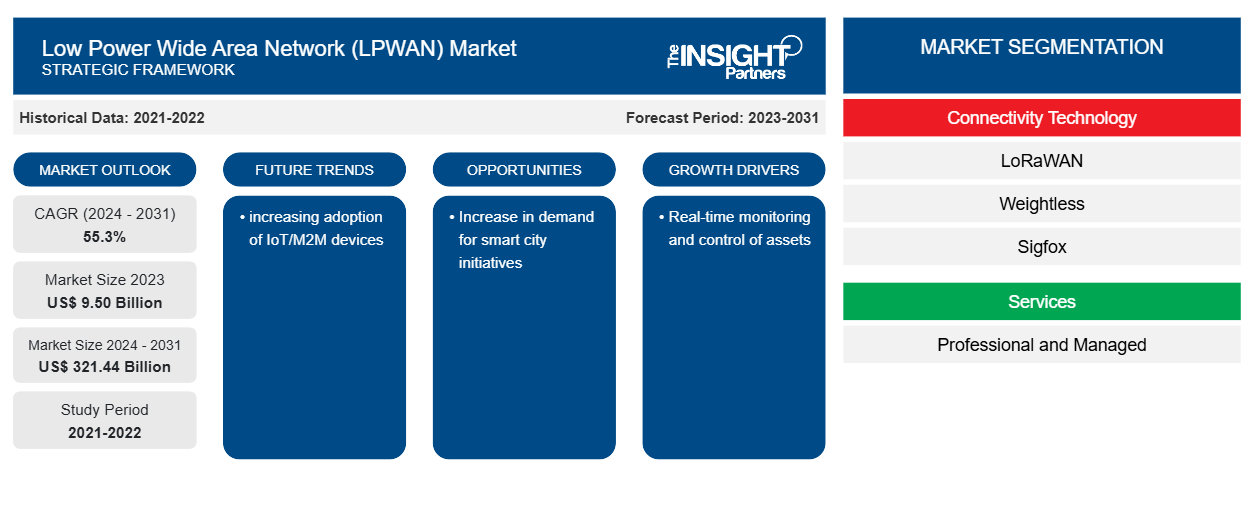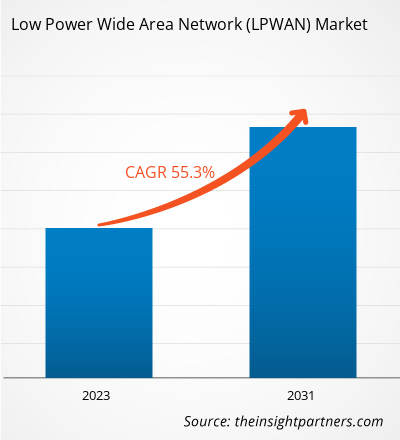低電力広域ネットワーク(LPWAN)市場規模は、2023年の95億米ドルから2031年には3,214億4,000万米ドルに成長すると予想されており、2024年から2031年にかけて55.3%のCAGRを記録すると予想されています。スマートシティインフラの急激な成長は、今後も市場の主要なトレンドであり続けると思われます。
低電力広域ネットワーク (LPWAN) 市場分析
低電力 WAN 市場の成長は、主にスマート シティ構想の需要増加や資産のリアルタイム監視および制御の必要性の高まりなどの要因によって推進されています。これらの要因は、スマート シティや資産管理システムの幅広いアプリケーションで効率的かつコスト効率の高い接続を可能にする低電力広域ネットワーク (LPWAN) の開発と実装に貢献しています。
低電力広域ネットワーク (LPWAN) 市場の概要
低電力広域ネットワーク (LPWAN) は、低ビット レートで長距離通信を可能にするワイヤレス テクノロジです。低電力デバイスをかなりの距離にわたって接続しながら、低データ速度を維持するように特別に設計されています。LPWAN は低コスト、低電力、広域接続を提供するため、長いバッテリー寿命と長距離でのデータ送信能力を必要とするデバイスに適しています。モノのインターネット (IoT) デバイスに対する低電力、広域接続の需要が高まっているため、LPWAN 市場は今後数年間で急速に成長すると予想されています。農業、医療、物流、輸送など、さまざまな業界で LPWAN テクノロジが実装されています。
要件に合わせてレポートをカスタマイズする
このレポートの一部、国レベルの分析、Excelデータパックなど、あらゆるレポートを無料でカスタマイズできます。また、スタートアップや大学向けのお得なオファーや割引もご利用いただけます。
- このレポートの主要な市場動向を入手してください。この無料サンプルには、市場動向から見積もりや予測に至るまでのデータ分析が含まれます。
低電力広域ネットワーク (LPWAN) 市場の推進要因と機会
市場を有利にする資産のリアルタイム監視と制御
LPWAN テクノロジーは、産業機器、農業機械、車両などの資産を効果的に監視および管理したい企業にとって理想的なソリューションを提供します。企業は機械の状態をリアルタイムで監視できるため、問題が深刻化する前に潜在的な問題を事前に特定して対処することができ、予期しないダウンタイムや高額な修理のリスクを軽減できます。さらに、企業は車両の位置を追跡し、ルートを最適化し、ドライバーの行動を監視することができるため、運用効率が向上し、コストが節約されます。
スマートシティイニシアチブの増加
スマート シティの取り組みは、都市サービスを強化し、住民の生活の質を向上させることを目的としています。これらの取り組みは、多数のデバイスに手頃な価格でエネルギー効率の高いワイヤレス接続を提供する LPWAN (低電力広域ネットワーク) テクノロジに依存しています。LPWAN は、スマート シティソリューションに不可欠な車両間通信や車両とインフラストラクチャ間の通信など、さまざまなアプリケーションを可能にします。
低電力広域ネットワーク (LPWAN) 市場レポートのセグメンテーション分析
低電力広域ネットワーク (LPWAN) 市場分析の導出に貢献した主要なセグメントは、接続技術、サービス、アプリケーション、およびエンドユーザーです。
- 接続技術に基づいて、市場はLoRaWAN、Weightless、Sigfox、NB-IoT、Wi-SUNに分かれています。LoRaWANセグメントは2023年に最大の市場シェアを占めました。
- サービスに基づいて、市場はプロフェッショナルとマネージドに分かれています。プロフェッショナルセグメントは2023年に大きな市場シェアを占めました。
- アプリケーション別に見ると、市場はスマート街灯、スマートメーター、スマートビルディング、スマート廃棄物管理、スマートパーキング、資産管理と追跡に分類されています。スマートメーターセグメントは2023年に最大の市場シェアを占めました。
- エンドユーザーに基づいて、市場はスマートシティ、石油・ガス、ヘルスケア、製造、物流・輸送、農業、民生用電子機器に分かれています。スマートシティセグメントは2023年に最大の市場シェアを占めました。
低電力広域ネットワーク (LPWAN) の地域別市場シェア分析
低電力広域ネットワーク(LPWAN)市場レポートの地理的範囲は、主に北米、アジア太平洋、ヨーロッパ、中東およびアフリカ、南米および中米の5つの地域に分かれています。北米は、その強力な産業基盤、イノベーションに対する政府の支援、高い購買力により、2023年に低電力広域ネットワーク市場を支配しました。この地域の成長は、主にモバイルおよびウェアラブルデバイスの需要の増加とIoTデバイスのニーズの高まりによって推進されています。ただし、アジア太平洋地域は、工業化の進展や自動化とデジタル化の需要の高まりなどの要因に後押しされ、最高の成長率を達成すると予測されています。LPWANテクノロジーは、スマートシティ、農業、物流、ヘルスケアなどの業界のIoTアプリケーションに特に適しています。
低電力広域ネットワーク (LPWAN) 市場の地域別分析
予測期間を通じて低電力広域ネットワーク (LPWAN) 市場に影響を与える地域的な傾向と要因は、Insight Partners のアナリストによって徹底的に説明されています。このセクションでは、北米、ヨーロッパ、アジア太平洋、中東およびアフリカ、南米および中米にわたる低電力広域ネットワーク (LPWAN) 市場のセグメントと地理についても説明します。

- 低電力広域ネットワーク(LPWAN)市場の地域別データを入手
低電力広域ネットワーク(LPWAN)市場レポートの範囲
| レポート属性 | 詳細 |
|---|---|
| 2023年の市場規模 | 95億ドル |
| 2031年までの市場規模 | 3,214.4億米ドル |
| 世界のCAGR(2024年 - 2031年) | 55.3% |
| 履歴データ | 2021-2022 |
| 予測期間 | 2023-2031 |
| 対象セグメント | コネクティビティテクノロジー
|
| 対象地域と国 | 北米
|
| 市場リーダーと主要企業プロフィール |
|
低電力広域ネットワーク (LPWAN) 市場のプレーヤー密度: ビジネスダイナミクスへの影響を理解する
低電力広域ネットワーク (LPWAN) 市場は、消費者の嗜好の変化、技術の進歩、製品の利点に対する認識の高まりなどの要因により、エンドユーザーの需要が高まり、急速に成長しています。需要が高まるにつれて、企業は提供を拡大し、消費者のニーズを満たすために革新し、新たなトレンドを活用し、市場の成長をさらに促進しています。
市場プレーヤー密度とは、特定の市場または業界内で活動している企業または会社の分布を指します。これは、特定の市場スペースに、その規模または総市場価値と比較して、どれだけの競合相手 (市場プレーヤー) が存在するかを示します。
低電力広域ネットワーク (LPWAN) 市場で事業を展開している主要企業は次のとおりです。
- Nwaveテクノロジーズ
- シグフォックス
- セムテック株式会社
- ロリオット
- リンクラボ株式会社
- ワビオット
免責事項:上記の企業は、特定の順序でランク付けされていません。

- 低電力広域ネットワーク(LPWAN)市場のトップキープレーヤーの概要を入手
低電力広域ネットワーク (LPWAN) 市場のニュースと最近の動向
低電力広域ネットワーク (LPWAN) 市場は、主要な企業出版物、協会データ、データベースなどの一次調査と二次調査後の定性的および定量的データを収集することによって評価されます。以下は、市場の動向の一覧です。
- フランス生まれの超狭帯域 IoT ネットワーク技術である Sigfox が、貢献メンバーとして LoRa Alliance に正式に参加しました。この動きは、Sigfox が 2022 年初頭に衰退と投げ売りを経験し、シンガポールを拠点とする Unabiz に買収された後に起こりました。新しい親会社は、LoRaWAN の専門家である Rémi Lorrain とともに、Sigfox の LoRaWAN 陣営への参入を促進しました。低電力広域ネットワーク (LPWAN) 分野における Sigfox と LoRaWAN の歴史的なライバル関係を考えると、この展開は重要です。
(出典:Sigfox、プレスリリース、2023年7月)
- Semtech は、Sigfox の「0G」テクノロジーを SX126x シリーズの LoRa チップセットに統合することに成功したと発表しました。この統合により、LoRaWAN やその他の LoRa ベースのネットワークとの互換性が実現します。この開発は、Sigfox テクノロジーをチップ レベルで組み込むという Semtech の継続的な取り組みの一環です。Semtech は以前、Sigfox テクノロジーを、マルチ コンステレーション GNSS やパッシブ Wi-Fi スキャン機能などの機能を提供する、手頃な価格の LCC68 トランシーバーや高度な LR シリーズに統合することに成功しました。
(出典:Semtech、プレスリリース、2022年12月)
低電力広域ネットワーク (LPWAN) 市場レポートの対象範囲と成果物
「低電力広域ネットワーク (LPWAN) 市場規模と予測 (2021 ~ 2031 年)」レポートでは、以下の分野をカバーする市場の詳細な分析を提供しています。
- 対象範囲に含まれるすべての主要市場セグメントについて、世界、地域、国レベルでの低電力広域ネットワーク(LPWAN)市場規模と予測
- 低電力広域ネットワーク(LPWAN)市場の動向、および推進要因、制約、主要な機会などの市場動向
- 詳細なPEST/ポーターの5つの力とSWOT分析
- 主要な市場動向、世界および地域の枠組み、主要プレーヤー、規制、最近の市場動向を網羅した低電力広域ネットワーク(LPWAN)市場分析
- 市場集中、ヒートマップ分析、主要プレーヤー、低電力広域ネットワーク(LPWAN)市場の最近の動向を網羅した業界展望と競争分析
- 詳細な企業プロフィール
- 過去2年間の分析、基準年、CAGRによる予測(7年間)
- PEST分析とSWOT分析
- 市場規模価値/数量 - 世界、地域、国
- 業界と競争環境
- Excel データセット



Report Coverage
Revenue forecast, Company Analysis, Industry landscape, Growth factors, and Trends

Segment Covered
This text is related
to segments covered.

Regional Scope
North America, Europe, Asia Pacific, Middle East & Africa, South & Central America

Country Scope
This text is related
to country scope.
よくある質問
The global Low Power Wide Area Network (LPWAN) market is expected to reach US$ 321.44 billion by 2031.
The key players holding the majority of shares in the global Low Power Wide Area Network (LPWAN) market are Nwave Technologies, SIGFOX, Semtech Corporation, LORIOT.IO, and Link Labs, Inc.
The increase in demand for smart city initiatives is anticipated to play a significant role in the global Low Power Wide Area Network (LPWAN) market in the coming years.
The real-time monitoring and control of assets offered by LPWAN are some factors that propel the global Low Power Wide Area Network (LPWAN) market.
The Low Power Wide Area Network (LPWAN) market size is expected to grow from US$ 9.50 billion in 2023 to US$ 321.44 billion by 2031; it is anticipated to expand at a CAGR of 55.3% from 2024 to 2031.
Trends and growth analysis reports related to Technology, Media and Telecommunications : READ MORE..
The Insight Partners performs research in 4 major stages: Data Collection & Secondary Research, Primary Research, Data Analysis and Data Triangulation & Final Review.
- Data Collection and Secondary Research:
As a market research and consulting firm operating from a decade, we have published and advised several client across the globe. First step for any study will start with an assessment of currently available data and insights from existing reports. Further, historical and current market information is collected from Investor Presentations, Annual Reports, SEC Filings, etc., and other information related to company’s performance and market positioning are gathered from Paid Databases (Factiva, Hoovers, and Reuters) and various other publications available in public domain.
Several associations trade associates, technical forums, institutes, societies and organization are accessed to gain technical as well as market related insights through their publications such as research papers, blogs and press releases related to the studies are referred to get cues about the market. Further, white papers, journals, magazines, and other news articles published in last 3 years are scrutinized and analyzed to understand the current market trends.
- Primary Research:
The primarily interview analysis comprise of data obtained from industry participants interview and answers to survey questions gathered by in-house primary team.
For primary research, interviews are conducted with industry experts/CEOs/Marketing Managers/VPs/Subject Matter Experts from both demand and supply side to get a 360-degree view of the market. The primary team conducts several interviews based on the complexity of the markets to understand the various market trends and dynamics which makes research more credible and precise.
A typical research interview fulfils the following functions:
- Provides first-hand information on the market size, market trends, growth trends, competitive landscape, and outlook
- Validates and strengthens in-house secondary research findings
- Develops the analysis team’s expertise and market understanding
Primary research involves email interactions and telephone interviews for each market, category, segment, and sub-segment across geographies. The participants who typically take part in such a process include, but are not limited to:
- Industry participants: VPs, business development managers, market intelligence managers and national sales managers
- Outside experts: Valuation experts, research analysts and key opinion leaders specializing in the electronics and semiconductor industry.
Below is the breakup of our primary respondents by company, designation, and region:

Once we receive the confirmation from primary research sources or primary respondents, we finalize the base year market estimation and forecast the data as per the macroeconomic and microeconomic factors assessed during data collection.
- Data Analysis:
Once data is validated through both secondary as well as primary respondents, we finalize the market estimations by hypothesis formulation and factor analysis at regional and country level.
- Macro-Economic Factor Analysis:
We analyse macroeconomic indicators such the gross domestic product (GDP), increase in the demand for goods and services across industries, technological advancement, regional economic growth, governmental policies, the influence of COVID-19, PEST analysis, and other aspects. This analysis aids in setting benchmarks for various nations/regions and approximating market splits. Additionally, the general trend of the aforementioned components aid in determining the market's development possibilities.
- Country Level Data:
Various factors that are especially aligned to the country are taken into account to determine the market size for a certain area and country, including the presence of vendors, such as headquarters and offices, the country's GDP, demand patterns, and industry growth. To comprehend the market dynamics for the nation, a number of growth variables, inhibitors, application areas, and current market trends are researched. The aforementioned elements aid in determining the country's overall market's growth potential.
- Company Profile:
The “Table of Contents” is formulated by listing and analyzing more than 25 - 30 companies operating in the market ecosystem across geographies. However, we profile only 10 companies as a standard practice in our syndicate reports. These 10 companies comprise leading, emerging, and regional players. Nonetheless, our analysis is not restricted to the 10 listed companies, we also analyze other companies present in the market to develop a holistic view and understand the prevailing trends. The “Company Profiles” section in the report covers key facts, business description, products & services, financial information, SWOT analysis, and key developments. The financial information presented is extracted from the annual reports and official documents of the publicly listed companies. Upon collecting the information for the sections of respective companies, we verify them via various primary sources and then compile the data in respective company profiles. The company level information helps us in deriving the base number as well as in forecasting the market size.
- Developing Base Number:
Aggregation of sales statistics (2020-2022) and macro-economic factor, and other secondary and primary research insights are utilized to arrive at base number and related market shares for 2022. The data gaps are identified in this step and relevant market data is analyzed, collected from paid primary interviews or databases. On finalizing the base year market size, forecasts are developed on the basis of macro-economic, industry and market growth factors and company level analysis.
- Data Triangulation and Final Review:
The market findings and base year market size calculations are validated from supply as well as demand side. Demand side validations are based on macro-economic factor analysis and benchmarks for respective regions and countries. In case of supply side validations, revenues of major companies are estimated (in case not available) based on industry benchmark, approximate number of employees, product portfolio, and primary interviews revenues are gathered. Further revenue from target product/service segment is assessed to avoid overshooting of market statistics. In case of heavy deviations between supply and demand side values, all thes steps are repeated to achieve synchronization.
We follow an iterative model, wherein we share our research findings with Subject Matter Experts (SME’s) and Key Opinion Leaders (KOLs) until consensus view of the market is not formulated – this model negates any drastic deviation in the opinions of experts. Only validated and universally acceptable research findings are quoted in our reports.
We have important check points that we use to validate our research findings – which we call – data triangulation, where we validate the information, we generate from secondary sources with primary interviews and then we re-validate with our internal data bases and Subject matter experts. This comprehensive model enables us to deliver high quality, reliable data in shortest possible time.


 このレポートの無料サンプルを入手する
このレポートの無料サンプルを入手する